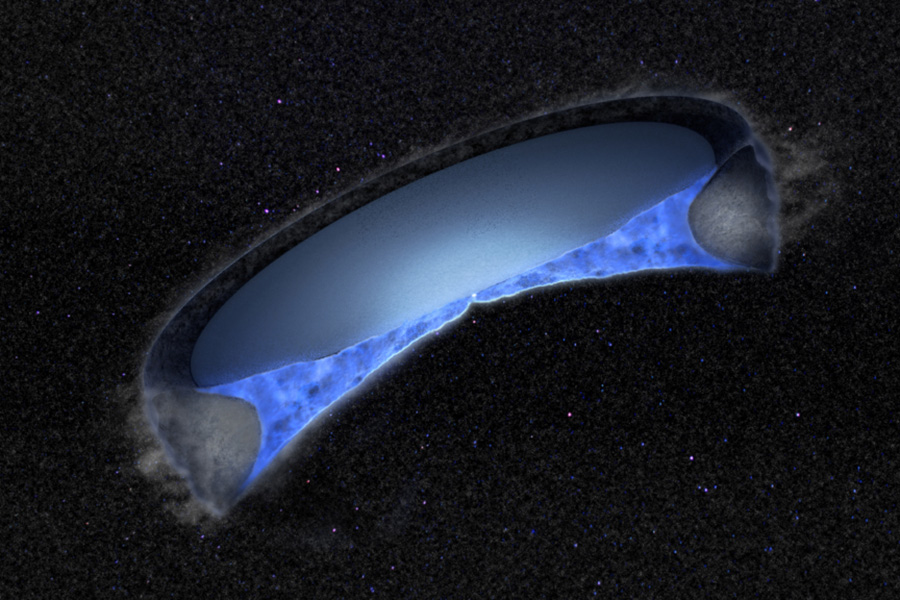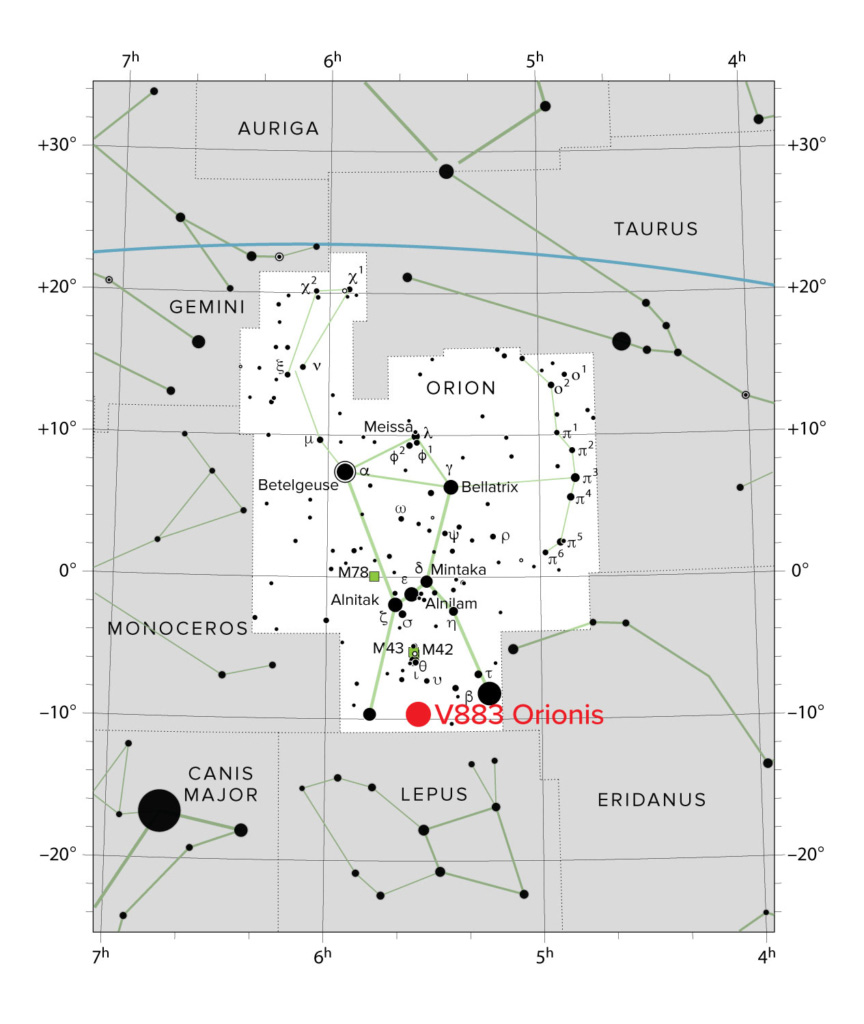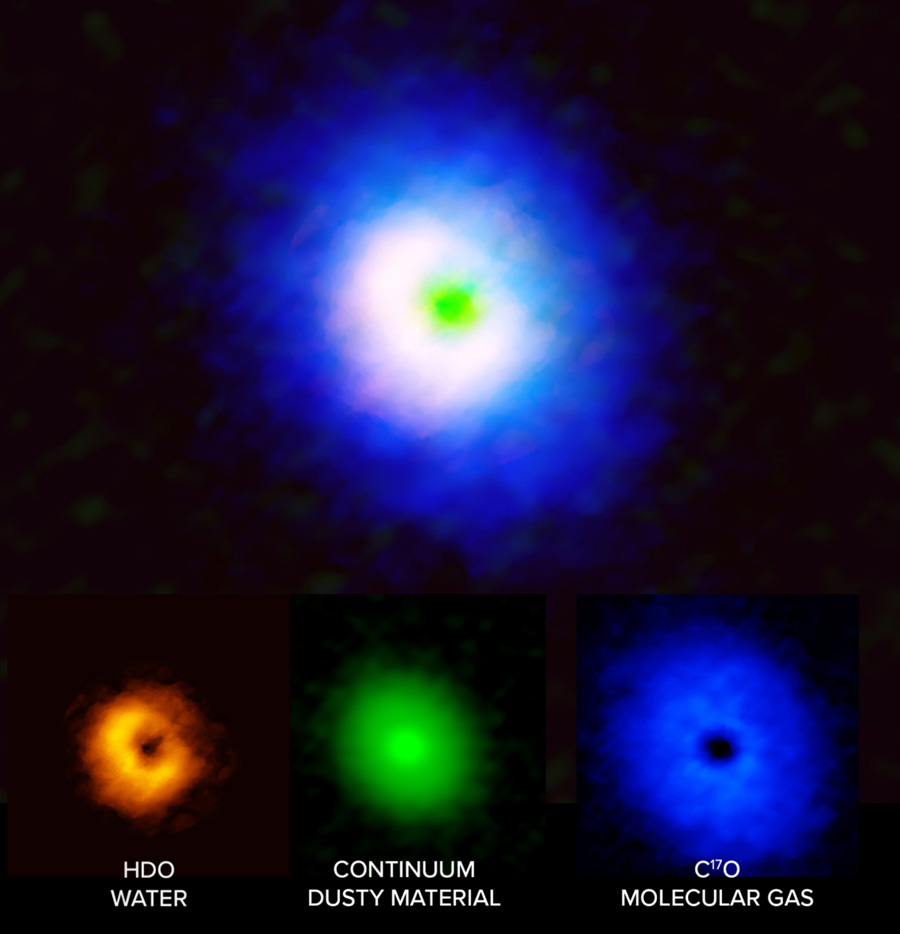Astronomers studying the water vapor around a newborn star find that it’s chemically similar to ice in solar system comets, a possible source of Earth’s oceans.

ALMA (ESO / NAOJ / NRAO), B. Saxton (NRAO / AUI / NSF)
Astronomers have discovered that some of Earth's water could predate the Sun. They spotted gaseous water in a planet-forming disc around the infant star V883 Orionis, with a chemical composition that's a close match to the water found in the solar system's comets. Similar comets might have delivered water to early Earth. Their observations — made with the Atacama Large Millimeter/submillimeter Array in Chile — provide a missing link, showing that habitable planets can inherit a portion of their water largely unchanged from the interstellar medium. The disk around V883 Orionis, which sits some 1,300 light-years away, contains at least 1,200 times the amount of water in all of Earth’s oceans.

IAU / Sky & Telescope
Water is arguably Earth's most distinctive feature. Much has been made about the search for water elsewhere the universe in the hunt for so-called Goldilocks planets, where temperatures might permit liquid water to exist. However, there's always been a gap in the story of how these planets ended up with vast quantities of H2O.
Astronomers have previously observed water in interstellar gas clouds and around young stars, and in the icy comets that patrol our solar system. However, it hasn't always been clear whether it's the same water along that whole journey, or whether there's another process that creates the cometary water at a later stage. “V883 Orionis is the missing link,” says team lead John Tobin (National Radio Astronomy Observatory). The team's findings are published in Nature.
To make their discovery, Tobin's team took advantage of a rare atomic anomaly. Most water molecules are a marriage of two hydrogen atoms and one oxygen atom. Yet sometimes one of the hydrogen atoms is replaced by an atom of deuterium — an isotope of hydrogen that contains a neutron in its nucleus. The ratio of the two varieties of water is an important chemical fingerprint, as it relies on the conditions under which they formed.
“The composition of the water in the disk is very similar to that of comets in our own solar system,” Tobin says. This implies that the water remains chemically unchanged as it passes from interstellar gas clouds, to new solar systems, and then to comets.
It might not just be water that survives the journey from interstellar space either. “An important consequence of this work is that other life-relevant species formed under similar conditions on [interstellar] dust grains, such as the amino acid glycine,” says Sergio Ioppolo (Aarhus University, Denmark), who was not involved in the research. Glycine acts as neurotransmitter in the central nervous system.

ALMA (ESO / NAOJ / NRAO), J. Tobin, B. Saxton (NRAO / AUI / NSF)
In order to make these measurements, Tobin's team had to find the right star. “Most of the water in planet-forming disks is frozen out as ice, so it’s usually hidden from our view,'' says team member Margot Leemker (Leiden Observatory, The Netherlands). Astronomers detect water in space by observing the radiation it emits as it vibrates. In ice those vibrations are restricted. However, V883 Orionis lent Tobin's team a helping hand. A dramatic outburst of energy from the star heated the disk, turning the water from ice to gas.
If comets are the main source of Earth's water, then the team's findings imply that most of our water is older than the solar system itself. Yet it remains unclear is whether comets played such a major role, because Earth's oceans have a lower deuterium/hydrogen ratio compared with the water observed around V883 Orionis.
Tobin suggests two possible explanations. Either high temperatures lowered that ratio over time, or the bodies that delivered the water to Earth had an intrinsically lower ratio all along. Other studies have pointed the finger at asteroids as the main delivery mechanism, with comets being responsible for just 1% of Earth’s water.
The next step for Tobin’s team is to use the upcoming Extremely Large Telescope (ELT) and its Mid-infrared ELT Imager and Spectrograph (METIS) instrument to look at other young solar systems. According to Leemker, “This will give us a much more complete view of the ice and gas in planet-forming disks.”
ALMA (ESO / NAOJ / NRAO), J. Tobin, B.Saxton (NRAO / AUI / NSF)
Editorial note (March 15, 2023): The role of glycine in biology has been corrected.
 9
9









Comments
Rod
March 13, 2023 at 8:44 pm
V883 Orionis disk is in the news, some reports I read indicate a massive disk at V883 Ori. ALMA traces history of water in planet formation back to the interstellar medium, https://www.sciencedaily.com/releases/2023/03/230308112055.htm
My observation. Some statements in this report are intriguing. “V883 Ori's disk is quite massive and is just hot enough that the water in it has turned from ice to gas.” My question – how massive compared to the MMSN used for the solar nebula? It looks perhaps more than 4300 earth masses given the mass of V883 Ori, some 1.3 solar mass.
“Although the Sun is believed to have formed in a dense cluster of stars and V883 Ori is relatively isolated with no nearby stars, the two share one critical thing in common: they were both formed in giant molecular clouds.” My note, this indicates some real differences between the MMSN used for the solar nebula and V883 Ori, much more isolated protostar*. The question of creating water after the BB and molecular clouds that later evolve into the Sun and planet Earth with plenty of water while Venus is not - looks intriguing. Same for many exoplanet reports.
You must be logged in to post a comment.
Mark Holm
March 13, 2023 at 11:31 pm
In this article, you wrote, “ Glycine is one of the amino acids that slot together to form DNA.” Glycine is an amino acid, but amino acids polymerize to form proteins, not nucleic acids.
You must be logged in to post a comment.
Monica Young
March 15, 2023 at 12:49 pm
Thanks for the catch! We've corrected the text.
You must be logged in to post a comment.
louis-robinson
March 14, 2023 at 12:01 am
Regrettably, it appears that the author & editor of this piece both slept through Introductory Biochemistry 😉
There are no amino acids in the structure of nucleic acids, which are composed of compounds that are, chemically, quite distinct from the amino acids that make up _proteins_. Intriguingly, there is evidence of the simpler nucleobases or their precursors in solar-system material. I can't recall seeing any reports of them in interstellar or protostellar contexts, but that may be because they're difficult to detect under those conditions [or, more likely, a simple lack of attention on my part].
You must be logged in to post a comment.
Monica Young
March 15, 2023 at 12:49 pm
Thanks for the catch! We've corrected the text.
You must be logged in to post a comment.
Yaron Sheffer
March 14, 2023 at 7:40 am
Is the cup of coffee I just had this morning younger than the water used to make it? Is my omelette younger that the eggs that compose it? Is the Solar System younger than the cloud material (including water) that collapsed to make a new spinning configuration? While the answer might have a philosophical angle to it, this story's title has been sensationalized a tad too much, imho.
You must be logged in to post a comment.
Monica Young
March 15, 2023 at 3:02 pm
Hi Yaron, good question, and I agree that the question is almost philosophical in nature. But it's chemical too — the "age" discussed here is the origin of the molecule. Did the hydrogens and oxygens that come together to form water in the presolar nebula actually survive to make it onto Earth? Or did they break apart in the heat of the newborn Sun, so that the water molecules we see on Earth formed later on, such as in the protoplanetary disk? And if water did form in the presolar nebula and eventually make it on to Earth, how did it do so? There's (astro)chemistry going on that we still don't fully understand, and studies like these seek to further our understanding.
You must be logged in to post a comment.
Yaron Sheffer
March 16, 2023 at 8:28 am
Or it might have been here all along...
https://www.science.org/doi/10.1126/science.aba1948
You must be logged in to post a comment.
Yaron Sheffer
March 16, 2023 at 8:34 am
Full story here:
https://www.abc.net.au/news/science/2020-08-28/where-did-earths-water-come-from/12598198
You must be logged in to post a comment.
You must be logged in to post a comment.